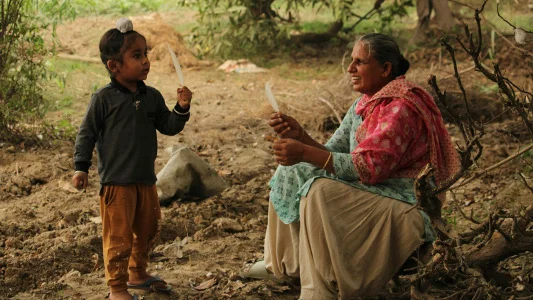Fighting diabetes with a kitchen garden

My name is Ikram, and I’m 52 years old.
When I was 16, I taught kids near my home. These children were from poor families and used to collect waste from the roadside. As I grew closer to them, I started to collect trash as well.
One day, an American Ambassador came and visited the children. They offered me the opportunity to come back to America with them and learn how to make cash from trash.
Adopting an unhealthy lifestyle
At home, I had a healthy lifestyle and a pure, healthy diet.
But in America, my lifestyle quickly became unhealthy. I didn’t eat well or exercise much. After some time, I started to feel constantly tired and thirsty and needed to urinate frequently.
I went to the hospital and shared my problems with a doctor. They advised me to take a blood glucose test.
Getting diagnosed as prediabetic
My blood glucose test revealed I was pre-diabetic.
After my diagnosis, I paid more attention to my health. I noticed that I often experienced the symptoms of pre-diabetes, and usually very suddenly. But sometimes, there were no signs at all.
I wasn’t very concerned about my diagnosis and followed a normal diet. However, I gradually started to feel the common symptoms of type 2 diabetes.
My type 2 diabetes symptoms
My earliest symptoms were frequent urination, trouble breathing, tiredness, unexplained hunger, low metabolism, and thirst.
Concerned about the frequent urination and increasing blood glucose levels, I returned to the hospital. There, I was diagnosed with type 1 diabetes.
My doctor also identified that my kidneys weren’t functioning properly, and prescribed medicines for me to start taking straight away, as well as low levels of insulin.
They asked me questions about my family and my family’s history of diabetes – My father was a diabetic, but he didn’t experience any complications from his diabetes and led a very simple life.
My diabetes was generally well controlled, but being diagnosed as a type 2 diabetic scared me and made me very anxious.
Struggling with infections and weight loss
Working with a waste management company, I was at a high risk of infection and suffered from them frequently.
Whenever I got an infection, it took a long time to heal. Sometimes, they caused serious complications.
After 10 years in America, I decided I’d learned enough about the different waste management technologies and techniques and that it was time to return home and run my own environmentally-friendly companies.
Chasing this dream, I worked very hard day and night.
I didn’t pay any attention to my health.
This neglect led to weight loss, as well as weakness, abdominal pain, eyesight problems, and fatigue. My body wasn’t able to make enough insulin, and my cells had stopped responding to it – The doctor said my insulin production was normal, but my insulin resistance was high and the sugar was staying in my blood.
They told me that over time I could face serious health complications and that my kidneys were at risk of failure, but that my heart was functioning normally.
I was relieved to hear my heart was okay, but I was very worried about my kidneys – Kidney complications can be life-threatening.
Thankfully, my doctor helped motivate me, reassuring me that type 2 diabetes could be managed successfully and that I could still live a long life as a type 2 diabetic.
The consequences of not taking insulin
Most people I spoke to who were suffering from type 1 or type 2 diabetes told me that there was no cure or medication for type 2 diabetes.
They told me that if I stopped taking my medicines, my diabetes would return, and I would go back to suffering.
However, I didn’t focus on any of their views because I had heard – and believed – that it was possible to reverse type 2 diabetes.
Not taking my medication, I often struggled to manage my blood glucose level. It was sometimes too high and sometimes too low. I wasn’t getting enough sleep, urinated a lot, and was often thirsty. I also started to lose weight.
On the positive side, I wasn’t stressed, obese or depressed, and I wasn’t having mood swings – Mood swings, caused by irregular blood glucose levels, are often a big problem among diabetics.
Adapting my lifestyle, and switching my diet to my kitchen garden
One of the key steps I took in getting my diabetes under control was adapting my diet.
I started avoiding outside food and instead focused on my own kitchen garden.
Every day, I ate a salad using my kitchen garden vegetables and plants, making very basic foods and following a simple diet.
And every morning, I went on a walk to stay fresh and happy.
I quickly worked out that if I wanted to stay healthy, I should eat healthy fresh food and exercise regularly.
My plants provided me with vitamins, minerals and carbohydrates. They kept my diet clean and healthy and also helped me manage my stress – Seeing my kitchen garden and plants thriving made me very happy and gave me a sense of fulfilment.
I recommend all diabetics keep their own kitchen garden!
Final thoughts
Keeping your sugar level in balance means keeping your stress level balanced as well – I believe high levels of stress, depression and anxiety can stop insulin-producing cells in your pancreas from functioning.
To combat my diabetes, I focused on my diet and maintaining regular exercise, spending at least one hour every day on physical activities.
And now, I’m living a healthy life. My blood glucose level is better, and I urinate much less frequently.
For other people like me, suffering from diabetes, I can’t say it enough – Diabetes is a life-threatening disease, but you can manage it, and you can fight against it.
I’m over 50 now, but I don’t have any concerns about my life expectancy because of diabetes. I’ve made up my mind to manage it, and I will.
Looking for more stories like this?
Learning to manage diabetic neuropathy was never in Nirvaanika's diabetes management plans. But one day, she woke up with a strange feeling in her feet.
Joining the workforce, Nirvaanika was keen to climb the corporate ladder. But first, she had to learn how to balance her work and her type 2 diabetes.
Nirvaanika is a type 2 diabetic and the primary caregiver for her type 2 diabetic mother. Her journey has been hard, but she’s grateful for it.








